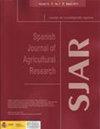A new approach for variable rate fertilization based on direct read of soil map image
IF 0.8
4区 农林科学
Q3 AGRICULTURE, MULTIDISCIPLINARY
引用次数: 0
Abstract
Aim of study: To develop a methodology for variable rate (VR) fertilization with less complexity in practice for variable rate fertilization. Area of study: Northwest of Iran. Materials and methods: A software was developed to read a soil map image pixel-by-pixel to provide the required information to tailor the fertilizer rate, regardless of which software was used for map generation. A total of 78 soil samples were collected and analyzed for soil potassium, and the results were used to generate an actual map including zones ranging from 70 to 190 kg/ha. The application rates were evaluated based on 50 deposition pans and compared with those calculated from the actual map. Based on the lag time in fertilization, three applied maps were also generated. Main results: The correlation coefficients found between the application rates computed based on the original soil samples and posted the locations of the sample points on the applied maps were 0.95, 0.95, and 0.94, over the ravel speeds of 6, 7, and 8 km/h, respectively. The results showed there is a correlation coefficient of 0.96 with an RMSE of 1.88 kg/ha, where the application rates computed from deposition pans compared with the corresponding location on the actual map. All applied maps were identical to the actual map. The results showed that the VR fertilization based on a direct read of a map image operated as expected. Research highlights: Fertilizer application was based on the direct read of map image. This study highlights also the need of new approaches in programing for simplicity of precision agriculture.一种基于土壤地图图像直接读取的变量施肥新方法
研究目的:建立一种在实际应用中简化的可变速率施肥方法。研究区域:伊朗西北部。材料和方法:开发了一个软件,可以逐像素读取土壤地图图像,提供所需的信息,以定制肥料比例,无论使用哪种软件生成地图。总共收集了78个土壤样本,并对土壤钾进行了分析,结果用于生成实际地图,包括70至190 kg/ha的区域。在50个沉积盘的基础上评估了施肥率,并与实际地图计算的施肥率进行了比较。根据施肥滞后时间,生成了3幅应用图。主要结果:在6 km/h、7 km/h和8 km/h下,基于原始土壤样品计算的施用量与张贴在应用地图上的样点位置之间的相关系数分别为0.95、0.95和0.94。结果表明,从沉积盘计算的施肥量与实际地图上相应位置的施肥量相比,相关系数为0.96,RMSE为1.88 kg/ha。所有应用的地图都与实际地图相同。结果表明,基于直接读取地图图像的虚拟现实施肥效果良好。研究重点:基于地图图像直接读取施肥。这项研究也强调了需要新的方法来简化精准农业的编程。
本文章由计算机程序翻译,如有差异,请以英文原文为准。
求助全文
约1分钟内获得全文
求助全文
来源期刊

Spanish Journal of Agricultural Research
农林科学-农业综合
CiteScore
2.00
自引率
0.00%
发文量
60
审稿时长
6 months
期刊介绍:
The Spanish Journal of Agricultural Research (SJAR) is a quarterly international journal that accepts research articles, reviews and short communications of content related to agriculture. Research articles and short communications must report original work not previously published in any language and not under consideration for publication elsewhere.
The main aim of SJAR is to publish papers that report research findings on the following topics: agricultural economics; agricultural engineering; agricultural environment and ecology; animal breeding, genetics and reproduction; animal health and welfare; animal production; plant breeding, genetics and genetic resources; plant physiology; plant production (field and horticultural crops); plant protection; soil science; and water management.
 求助内容:
求助内容: 应助结果提醒方式:
应助结果提醒方式:


